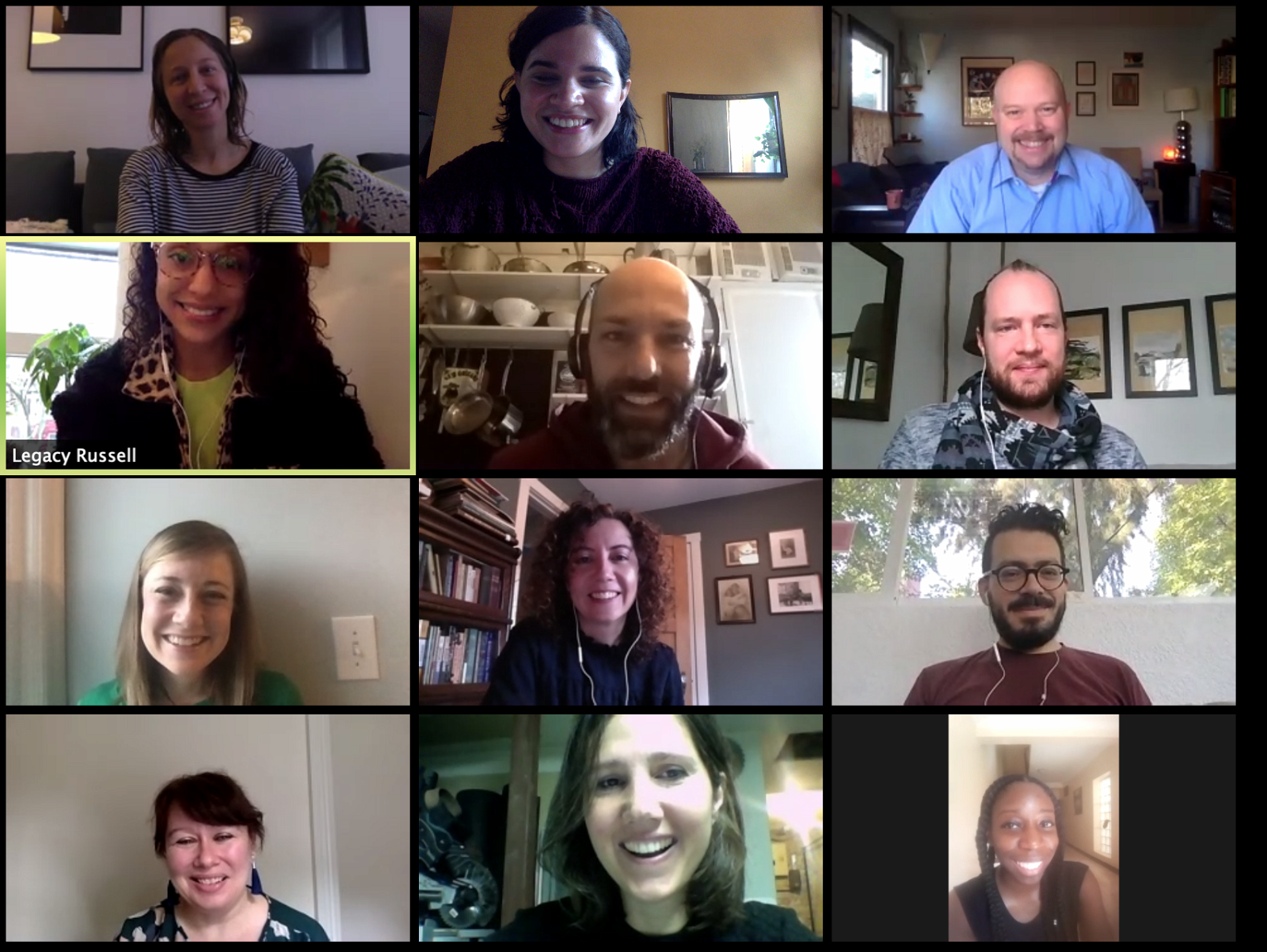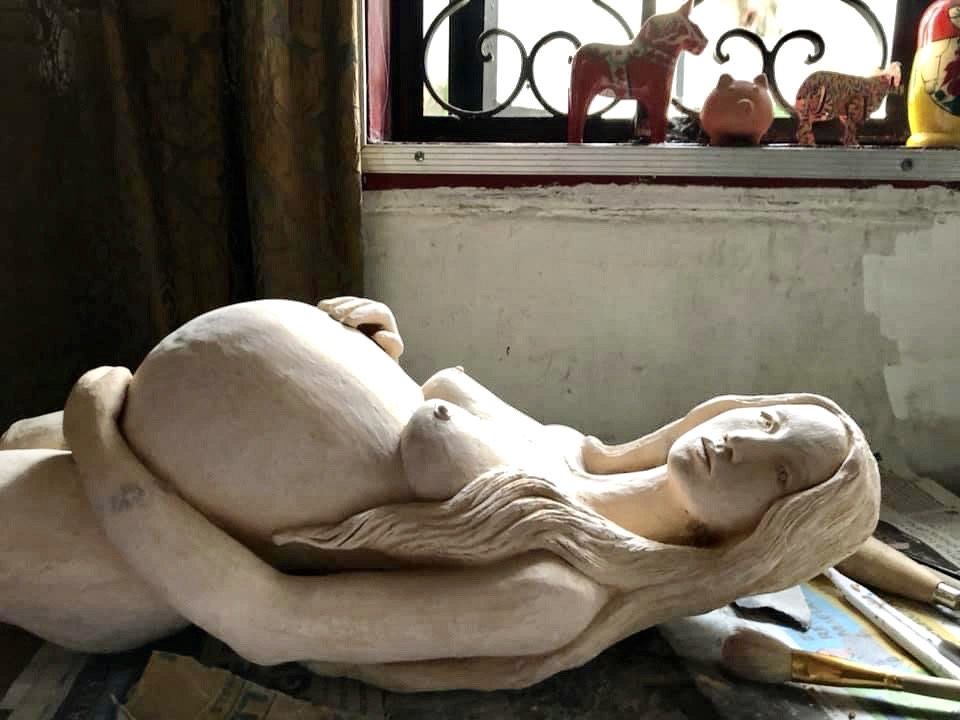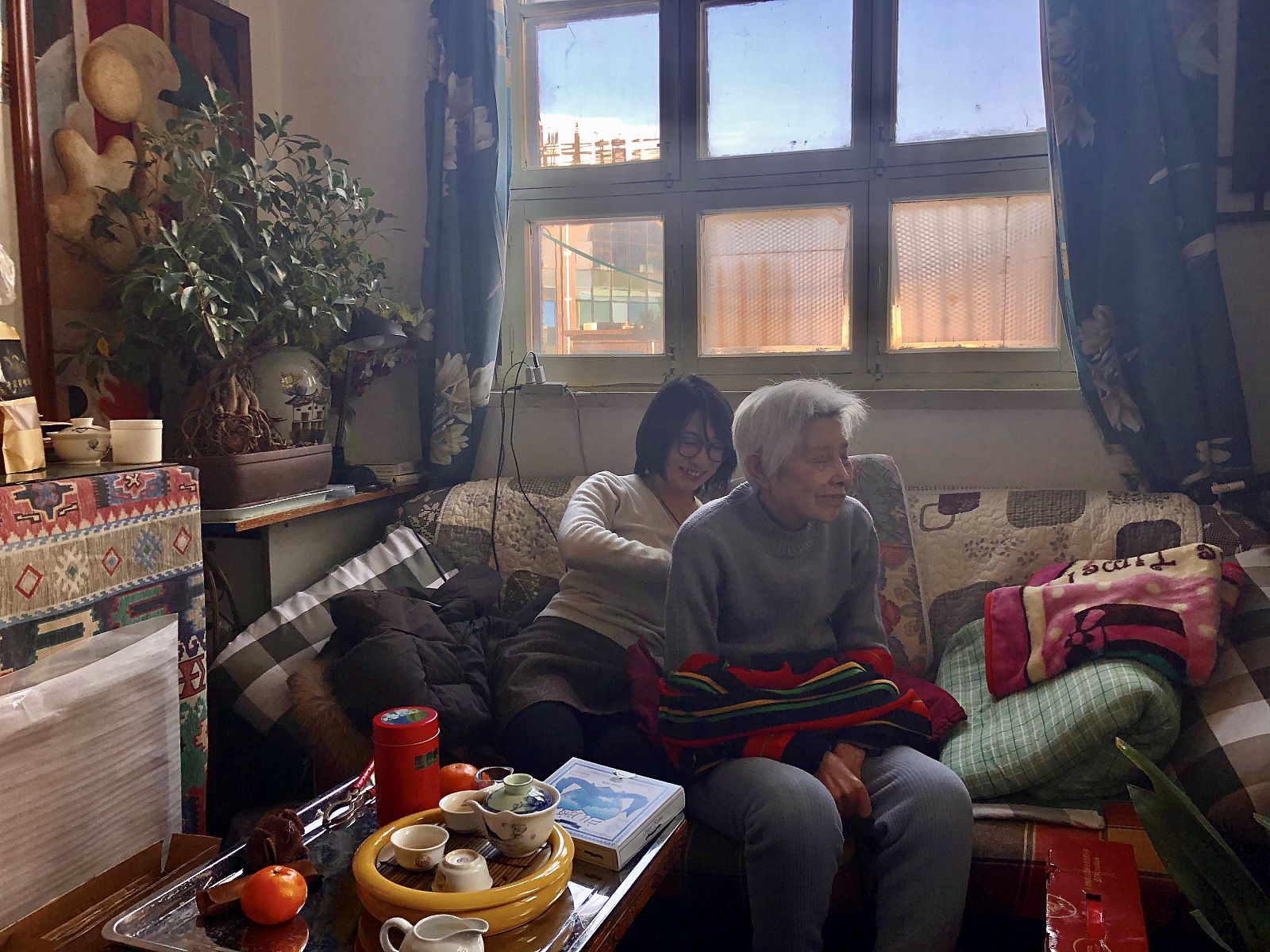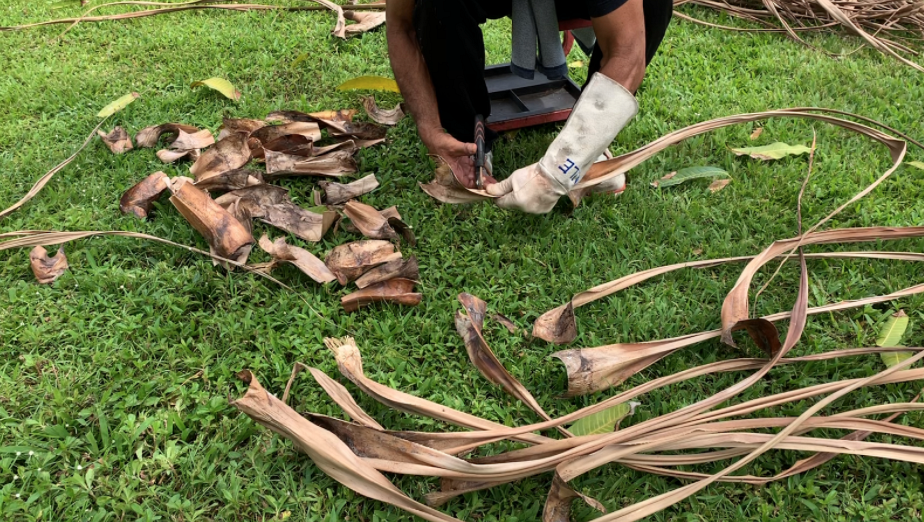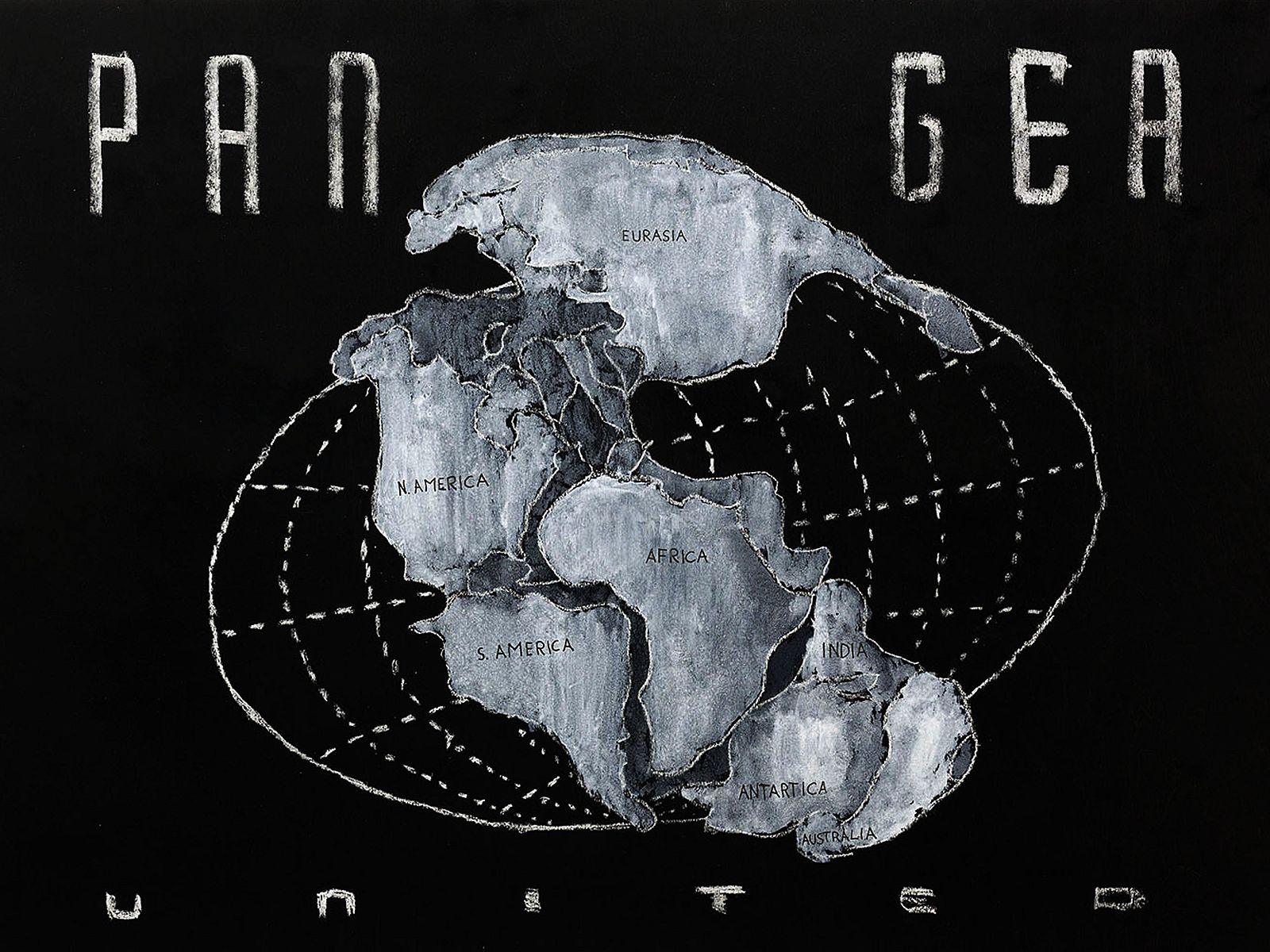Following the COVID-19 crisis, a number of Curatorial Intensive Alumni came together via Zoom to discuss how the global crisis was affecting their respective communities. This conversation brought up questions of curatorial labor, the use of technology, loss of privacy, and navigating public and private space in a digital landscape.
Maayan Sheleff, an alumna of the Curatorial Intensive in New York in 2010, took part in these Zoom meetings, and she reflects the questions they generated as they relate to her own practice and PhD studies in her text, "Unsafe Safety". Sheleff writes from Tel Aviv, Israel. To read and download the PDF version, click here.
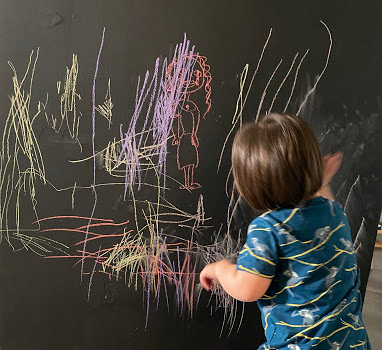
Maayan’s son, Cole, practicing art at home.
How does one write a curatorial report about the COVID-19 pandemic? Should it be a report about the position of curators during the crisis? When we are in the midst of a crisis, reacting in a posed, thoughtful, critical manner is almost impossible. Perhaps writing about the position of this one curator, caught in her own private space, perhaps that is enough for now. And what is curating anyway, if not collecting random threads of thoughts and feelings of others, caring about them, and trying to make sense out of them?
We are all in our private spaces now, but they don't necessarily provide us with any privacy or safety. As a curator I often work with activist and participatory practices, some involving technology and online participation, and others physical assemblies in public space. The tension between the private and the public spheres is always there, as well as the tension between feeling safe and being taken out of your comfort zone towards a new engaging experience. However, it seems like the current events intensify this tension. In fact, it feels like it enhances everything. All the problems that activists and political artists already dealt with—-precarious labor conditions, the rise of dictatorships and right wing agendas, “fake news” and propaganda, surveillance against civilians, lack of care and solidarity, the Anthropocene/ Capitalocene, all this and more—seem to be accelerated to a perplexing bubble of anxieties.
One could think of it through good old Freud's notion of the uncanny: When we are in our homes now, or walk in the streets, we feel as if something that has been reassuring and homely became estranged and unsettling. But in fact, the manifestations of the uncanny as a psychological neurosis are the return of what has been repressed, hidden, which comes to light as a recurrence, repetition, echo1. The occurrence of the repressed can turn any emotion into a morbid anxiety, even if it is in fact not new to us. The virus is multiplying, repeating itself, seeping between the cracks of what was already there.
In a recent article2 for “Spy On Me," a publication accompanying the performance festival organized by HAU in Berlin, Frederike Kaltheuner and Nele Obermüller wrote: “Privacy creates the safe space within which we are not judged, assessed or categorized. It is the space in which we can develop our identity, change who we are and decide who we want to become.”. However, as the increased use of digital connectivity imposes obvious threats on our privacy, it might also be useful to think about the changes of both our physical and mental private spaces. Our homes are no longer a safe space for everybody. For some, the threat of violence within their homes is increasing, particularly during the COVID-19 Pandemic. Others don't even have a home to stay in. Our consciousness is also under threat, constantly haunted in a way by the voices and images of others, as all our information comes in mediated forms.
The article discusses the loss of privacy that new technology entails, and how it affects different people in a different way and increases old forms of discrimination. The writers mentioned how cheap phones for example, come with poor security and are used to harvest people's data. They are usually sold to those who are already at risk of being abused by surveillance, the poor or those who are new to the internet. The authors also noted how face recognition algorithms perform best with white men, and make most of their mistakes with black women, increasing the probability of false accusations. However, some researchers are slow to endorse improving those algorithms, thus exposing communities who are already discriminated against, to better surveillance. A similar thought could be applied to the new accelerated use of Zoom conversations, events and remote teaching. On the one hand, this technology is only available to those who have access to a computer and strong internet connections, leaving behind many who can't work from home and thus protect their jobs, or can't continue to educate their children.
On the other hand, who is to say that this is what those people, or any of us for that matter, need at the moment? Can we really work from home when our children are there—personally, I have a two year old son—when we are suffering from physical or emotional distress? What about single mothers or fathers, who already have so much immaterial labor and no support systems? What about those who are starving? Is a remote lesson or a zoom performance what they really need? Should they be exposed to further surveillance and leave more digital traces that can be abused later on?
I'm sure that all of you have felt the acceleration of digital content and connectivity. To some, this causes an increased sense of ‘fomo’. As curators, some of us feel like we can't do anything at all: our projects are canceled, funding is impossible to get and maybe we also feel like we need more time to process what all of this means. Others feel obliged to create new content, formats and thought rapidly to stay relevant and perhaps manage to make a living. Some don't have a choice, as the institutions they work for must prove themselves useful in order to keep their staff. As someone who was always simultaneously an independent curator and an employee in small non-profit institutions, I feel both ends of the scale.
In her book Undoing the Demos, Wendy Brown3 described Neo-Liberal logic via the expectation to constantly enhance one’s self-value: on the one hand through shaping one’s “portfolio” to attract investors, for example in social networks, and on the other through top-down governing techniques using teamwork and networking. Thus collaboration could easily turn into another form of individual self-enhancement on the way to strengthening one’s competitive positioning for future self-value. In Neo-Liberal logic, everything is a market and we are all market actors, in competition rather than in exchange with each other, in order to increase our ranking. Solidarity, commoning or collective citizenship thus becomes hard to find. When we are measured as human capital, inequality becomes the norm as the world divides into winners and losers. The state as well pursues justice and human rights only if those turn into profit and debt reduction (as in the case of the mortgage crisis in the US and the German treatment of South European debt). The principles of democracy such as freedom, sovereignty and equality are transformed in Neo-Liberal logic from the field of politics to the field of economy, and then hollowed out, thus changing homo-politicus into homo-eoconomicus (Foucault). Neoliberalism thus limits the life of its citizens to mere concern with survival and wealth acquisition, writes Brown.
In this regard it is interesting to think about the relations between the virus and digital virality: as it feels like the online space is the only public space that we are allowed to roam, our need to be visible on the internet increases to the point that it becomes hard to breathe. In a recent article for The New York Times4, titled “The Coronavirus Is Us”, Michael Marder interprets the Coronavirus as a political wake-up call, a figuration of the social and the political world — or as he puts it, "the bug is not a bug but a feature.” In a world in which walls and borders closing were already signs of increasing nationalism, the COVID-19 crisis serves as an excuse to put further obstacles on the freedom of movement, give the citizens a false sense of security and divert their attention from poor governance and the inability to tackle burning issues such as climate change, migrant crisis, the state of public health systems and others. While the details are different in various localities, this seems to be a repeating habit of governments these days.
In Israel for example, prime minister Netanyahu has been busy in what the Washington Post called a coup, with the pandemic as cover5. Among various actions, too many to mention here, he managed to persuade his political opponents to give up any plan, agenda or rule they ever had, in order to set up an “emergency government”. While playing on their patriotic sentiments, he delayed his court hearing, and continues to serve as prime minister while being under serious legal allegations. In fact, one of his first actions was to close down the courts until further notice. He also managed to get a tentative approval of the annexation of the Jordan Valley and the C territories in the West Bank in the summer, which he strives to conduct as long as his ally Trump is still in power. In addition, he ordered the Shabak (Shin Bet- the Israeli Security Agency) to monitor citizens' cell phones for movement, and is now debating transferring their data to the private Israeli surveillance company NSO Group—-yes, the same one that was sued by Facebook and WhatsApp for allegedly breaking into the phones of diplomats, political dissidents and journalists across the globe in order to help governments monitor them6. In addition, this last weekend, the National Security Council debated together with military Intelligence officers, how to suppress a potential civilian rebellion.
Under these overwhelming processes, conducted so quickly, it is no surprise that activists, artists and curators who work with political practices feel overwhelmed when thinking of a possible reaction. But going back to Marder's article, this centralized governmental attitude, according to him, is symbolically reflected in the Coronavirus, or in its crown, the spikes coming out of the virus that gave it its name. This virus, that does not obey natural systems of classifications and species boundaries, transgresses old borders and “becomes a figure of sovereignty in the age of the dispersion of power”. Marder goes on to explore notions of viral activity, to infiltrate and transcribe the texts of host cells and computer systems, as well as replicate itself widely. In social media virality is coveted in order to influence through dissemination: “Going viral introduces a fair degree of complexity into our affective relation to viruses: feared, when we become their target and possible hosts; desired, when they are our instruments for reaching a sizable audience”. The Coronavirus is virality manifested through our bodies, as it caught its hosts when they disseminated themselves over airplanes and cruise ships, in a global interconnected world. The virus reminds us that borders are porous, and as we will host elements that are alien to us, we must learn to live with them rather than “conjure up the specters of sovereign nation states.”7 Going back to Netanyahu (sorry, one last time), while I'm writing this report, during a memorial service at Yad Vashem Museum, on the Holocaust Memorial Day, Netanyahu literally said that the Corona virus emphasizes the importance of national serenity. And then he said something even more unbelievable in its rhetorics: he said that unlike in the Holocaust, this time we recognized the danger on time.
The crown metaphor and the new limitations on the freedom of movement reminded me of a seminar I took last year with professor Andre’ Lepecki8, titled Dance and power: choreopolitics in neo-authoritarian times. Lepecki mentioned the book “Orchésographie," a study of late sixteenth-century French Renaissance social dance written by Thoinot Arbeau. The book includes descriptions and drawings of dances “from the court to the countryside” and notations of relevant music tunes. In his book, “Exhausted Dance,” Lepecki mentions this guide as the first appearance of choreography (literally meaning “the movement of the choir”) as a method to be learned and practiced and showed its relation to modernity and its making of the subject as ‘kinetically disciplined’. “Orchésographie” is written as a sort of score but with no intention of having individuals interpret it their own way. Instead, it is meant to be a strict guide. It is the first instance of choreography in writing, in which the writing by itself becomes performative as it is drawn to mirror and lead specific movements. Interesting as well is that the first example of choreography in the book is a military parade, relating the movement of the collective and the individual to serving the state apparatus. The ordering of the liberal subject happens in the transfer from the order of the movement of the choir, or the collective, to the invention of choreography as art form captured under the state power (King Louis XIV). The ordering of freedom thus has always been the ordering of movement. Teaching the bourgeoisie how to dance was also teaching them how to move in society, how to be part of a political order. The fifteenth century also saw the beginning of slavery, another pre-capitalist technology of the ordering of the body. However, slavery was forced movement, as opposed to the “voluntary” ordering of choreography.
The choreography of the body also has a subversive potential, as we see in demonstrations as well as in political performative practices, reflected in numerous theories, from Lepecki to Judith Butler and others. Not only in projects related to the realm of dance, but also in the collective and participatory “pre-enactments”9 of the artist group Public Movement (IL), or the assemblies, summits and trainings of artist Jonas Staal (NLl), among many others. But how can we use our bodies now, to subvert the limitations imposed upon it? When all we seem to have is alienated virtual tours in deserted museums, and putting art under the gaze with no ability to touch, smell, listen, with no actual choreography of the body. It almost feels like the museums have turned into mass graveyards for artwork, which we could visit as a sort of memorial act.
The surge of virtual tours and documented Zoom conversation, brings to mind another question: what is online participation going to look like in the future? What new forms of participatory art practices can come out of this? It always takes time, from a moment a new medium appears to the moment in which art can use it in a meaningful way (unless you are Nam June Paik). In the essay by Walter Benjamin “The Author is Producer,"10 Benjamin claims that a political author must address and change the means of production, and he speaks of Brecht’s epic theater and its method of working against creating an illusion for the audience. He mentions Brecht’s songs as one example of “montage," a technique taken from the period’s new modes of production of film and radio, a montage that interrupts any illusion of continuity and thus calls for alert, critical viewing. Perceived from this distance, the viewer is able to see the conditions of his own life as astonishing, no longer self-evident.11
These days, it seems more and more difficult to view the world critically. Not able to sense the world with our own senses, confined to mediated forms of perception, we become more vulnerable to illusionist “fake news” and propaganda. In the article Breaking from the Government of Publics12, Paolo Caffoni describes the difference between a public and a crowd: the bond that forms a public does not depend on physical contact, but is defined as the “action at a distance of one mind upon another” (Tarde).13 Communication technologies separate bodies but unite minds in the conviction of a particular idea or desire shared simultaneously by others. The greater the size of the public reached by a certain idea, the more topical it will seem, and the more it will continue to expand exponentially. While crowds are created in space, publics are created in time. One could be part of only one crowd at any given moment but can belong to multiple publics at the same time. These fragmented subjectivities undermine processes of belonging and negate subjective perceptions: “The device for governing publics also involves this control of time: the expansion of topicality as a single temporal dimension of what is sensible corresponds to the elimination of any historical consciousness... News increasingly rushes in with information constantly updated, condemning us to live in an eternal present, in a “world without memory, where images flow and merge, like reflections on the water” (Debord).14
Caffoni goes on to explore the possibility of subverting or reversing the signs and forces of the spectacle, and gives historical examples, from Gabriel Tarde who interpreted the massive circulation of newspapers in Paris as the new phenomenon that had led public opinion to the 1789 Revolution, to Dziga Vertov's theoretical platform for a communist decoding of the world-a subversive use for the then new “kino-eye"-film camera (1926)15. He then points to the circulation of low-resolution images on the web as one of the key features of the upheavals that began in 2008 around the globe.
One could also think about projects like the Yes Men's tactical media, or the Institute for applied Autonomy's propaganda and graffiti robots, among other contemporary examples, as reminders of potential subversive uses of technologies that also casts a reflexive and critical look on the medium itself.
As curators, our work builds upon the work of others, of artists mostly (and if we aspire to be political, then of activists as well). We mustn't stop thinking about them in these difficult times, continue to aspire to find ways to enable, support, and disseminate their work. Most likely, and with the risk of sounding optimistic or sentimental, they are the ones who could turn this crisis into a vehicle for change. After many conversations with fellow curators and artists, one question that continues to come up is how to create platforms of care and solidarity under these conditions. For me, it is also a question of forms and formats of participation. In a conversation with artist Jonas Staal and curator Florian Malzacher a few days ago, Jonas said that perhaps we should work on creating an infrastructure that will enable a feeling of “unsafe safety.”. Not like the fake safety granted by the security measures taken by our governments, one that makes us feel unsafe more than anything, but a sense of being cared for enough to be able to take risks. I think that perhaps with this unsafe safety, if we are lucky enough to conjure it for ourselves, or even luckier to generate it in others, a transformation can come.
Footnotes:
1) Sigmund Freud, The Uncanny, in: The Standard Edition of the Complete Psychological Works of Sigmund Freud, Volume XVII (1917-1919): An Infantile Neurosis and Other Works (Vintage Classics, 2001), pages: 217-256
2) Frederike Kaltheuner and Nele Obermüller, New Technologies, Old Discrimination, in: Spy On Me#2-Artistic Maneuvers for the Digital Present, festival publication, March 19-29, 2020, Hebbel Am Ufer, Berlin, Germany
https://www.hebbel-am ufer.de/fileadmin/Hau/website_material/pdfs/HAU_SpyOnMe2_ENGL.pdf
3) Wendy Brown, Undoing the Demos: Neoliberalism's Stealth Revolution (NY: Zone Books, 2015), pages: 30-36
4) Michael Marder, The Coronavirus Is Us, The New York Times, March 3, 2020
5) Gershom Gorenberg, With the pandemic as Cover, Netanyahu is carrying out a coup in Israel, March 19, 2020
https://www.washingtonpost.com/opinions/2020/03/19/with-pandemic-cover-netanyahu-is-carrying-out-coup-israel/
6) See one example out of many for reports on this issue here: https://www.nbcnews.com/tech/security/facebook-sues-israel-s-nso-group-over-alleged-whatsapp-hack-n1073511
7) Michael Marder, ibid
8) Dance and power: choreopolitics in neo-authoritarian times, seminar with professor Andre’ Lepecki on performance and politics, Kelim Choreography Center, Bat Yam, Israel, 2019, supported by Artis and Outset
9) The concept of pre-enactment was coined by Dana Yahalomi, the leader of Public Movement, and sited often both by theoretician Oliver Marchart and curator Florian Malzacher. Pre enactment is the enactment of an event that has not yet happened, or, as Marchart puts it, “the artistic anticipation of a political event to come”. More specifically, Marchart describes it as a training for a future outbreak of a conflict. As such, it invites a reiteration of the performance in a political context, if one should occur. Oliver Marchart, Conflictual Esthetics, Artistic Activism and the Public Sphere, Europe: Sternberg Press/ US: the MIT press, July 2019, p 114
10) Walter Benjamin, The Author is Producer, New Left Review I/62 (July August 1970), originally written as speech in 1934
11) Frederic Jameson, Brecht and Method, London: Verso, 1998
12) Paolo Caffoni, Breaking from the Government of Publics, with diagrams by Falke Pisano, in: Regarding Spectatorship: Revolt and Distant Observer, an ongoing research project curated by Marianna Liosi and Boaz Levin exploring the notion of mediated political spectatorship, 2015
http://www.regardingspectatorship.net/23/
13) Gabriel Tarde, Preface to the Second Edition, in id., The Laws of Imitation, trans. Elsie Clews Parsons (New York: Henry Holt and Company, 1903 [1895]), xiv.
14) Paolo Caffoni, ibid, quoting G. Debord, Comments on the Society of the Spectacle, op. cit., 14, Thesis VI.
15) Dziga Vertov, Kino-Eye: The Writings of Dziga Vertov, ed. Annette Michelson, trans. Kevin O’Brien (Berkeley and Los Angeles: University of California Press, 1984).

